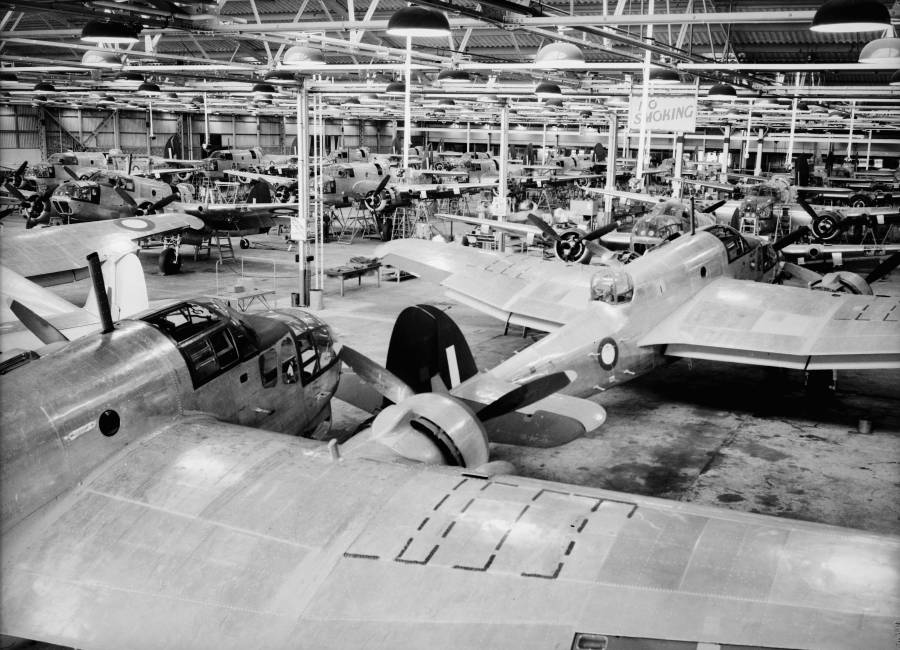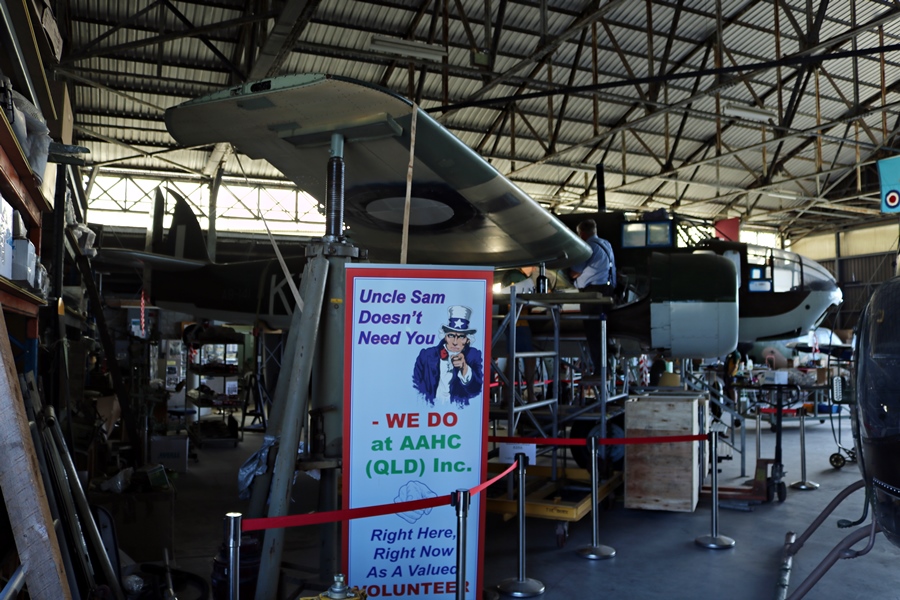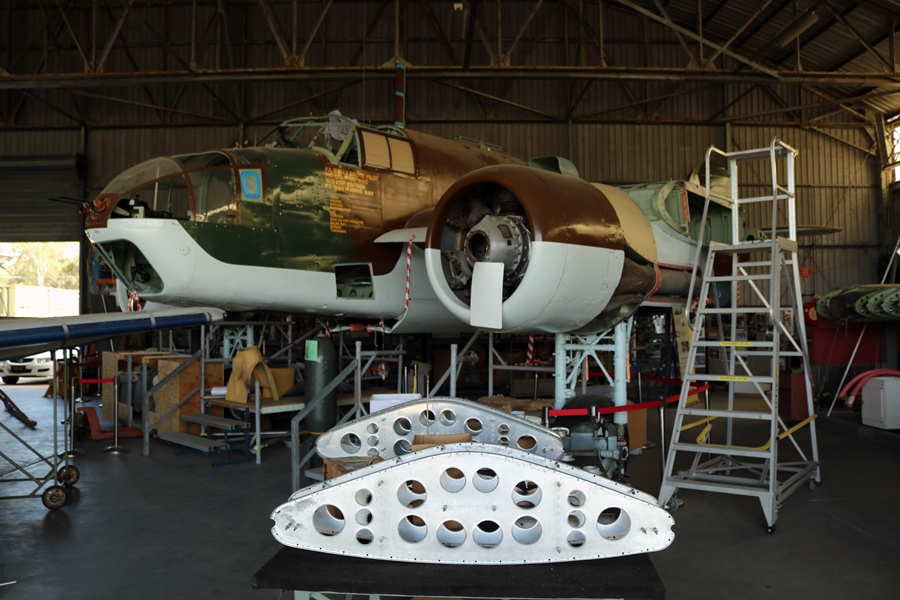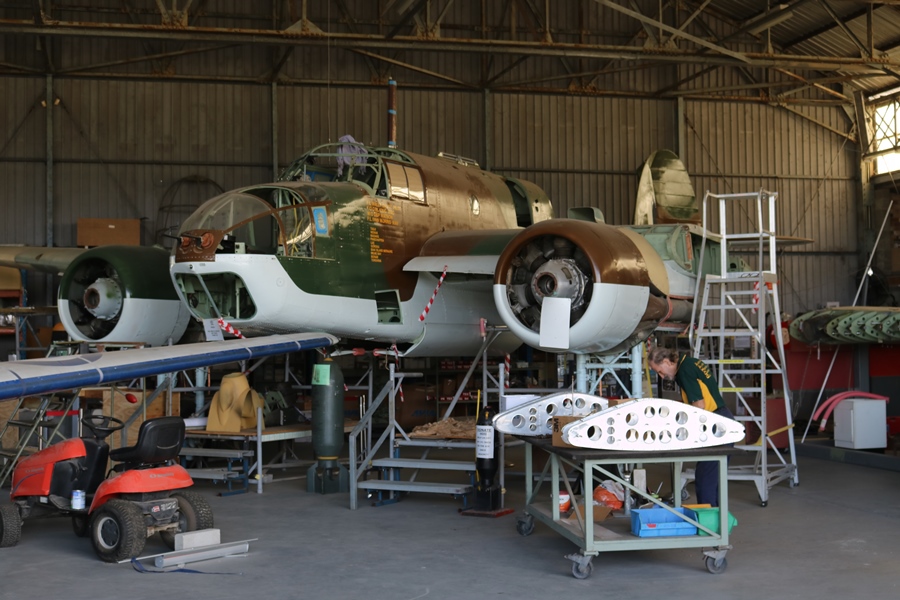During World War Two the Australian Department of Aircraft Production (DAP) licence built 700 Bristol Beaufort torpedo bombers for the Royal Australian Air Force (RAAF). They conducted maritime patrol, anti-shipping, maritime reconnaissance, bombing and training duties in Australia and the South West Pacific theatre.

The Beaufort’s were constructed at the main DAP factories in Fishermens Bend in Victoria, and Mascot in New South Wales. Due to the scale of the production in a relatively new industry in Australia, component parts were subcontracted out to 600 suppliers, including state railway workshops in Victoria, NSW and South Australia.
The first DAP Beaufort was test flown in August 1941 and the last aircraft was completed in August 1944. This production run included 50 Mk.V (originally intended for the Royal Air Force), 30 Mk.Va with a larger tail, 40 Mk.VI, 60 Mk.VII and 520 Mk.VIII – an improved version with ASV radar. Initially 180 of these were ordered for delivery to the Royal Air Force but only a six Mk.V were delivered to Singapore and with the rapid advance of the Japanese in 1941/42 they were withdrawn to Australia and these along with the rest of the order were reassigned to the RAAF instead.



Operated by numerous RAAF squadrons and units, the DAP Beaufort was successfully used against Imperial Japanese Navy ships and submarines across the South West Pacific theatre. They were also used to bomb land based targets and conduct maritime patrol, convoy escort and reconnaissance duties. They flew operationally with No. 1, 2, 6, 7, 8, 13, 15, 32 and 100 Squadrons.
The DAP Beaufort had a crew of 4 (Pilot, Navigator/Bombardier and two Wireless Air Gunners) and was powered by two Pratt and Whitney R-1830 Twin Wasp radial engines (licence built by the Commonwealth Aircraft Corporation), which replaced the original British Taurus engines (top speed 431 km/h / 268 mph). The Beaufort had a 990kg (2,000 lb) bomb payload or would carry a single torpedo. 0.303″and later 0.5″ machine guns were mounted in various configurations in the nose, wing and dorsal turret. The Mk. VIII could also carry sea mines and was fitted with APV air to surface radar sets and antenna for maritime reconnaissance.
From 1943, 46 DAP Beaufort bombers were converted into Mk.IX unarmed transport aircraft for RAAF communication duties at the Essendon Repair and Modification Centre in Melbourne. With the gun turret removed, the cabin was modified to carry 5 passengers and they were dubbed “Beaufreighters” (assigned serial numbers A9-701 to A9-746).

Obsolete by 1945, after the war most DAP Beaufort torpedo bombers and transports were retired from RAAF service. A few were retained to conduct miscellaneous duties including spraying experiments and were deployed against a great locust plague in 1947!
The Survivors
Today few complete DAP Beaufort torpedo bombers remain. Around 5 cockpit sections are on display, under restoration or in storage at museums in Australia – A9-152 and A9-210 Australian National Aviation Museum, A9-164 Gippsland Armed Forces Museum, A9-501 under restoration for the Arnhem Historical Society in Gove, Northern Territory and A9-703 at the private Camben Museum of Aviation. Currently the only complete restored aircraft are the Australian War Memorial Beaufort Mk.VIII A9-557 (flew 102 missions with RAAF No. 100 Squadron in New Guinea 1944 to 1945, crashed in 1945, restored by 2003, fitted with the cockpit of A9-461 – currently in storage) and the RAF Museum Hendon Mk.VIII A9-559, which is a composite of a number of RAAF aircraft (it is displayed as RAF Bristol Beaufort Mk.IIA DD931/L).

The Australian National Aviation Museum at Moorabbin, Victoria is restoring Beaufort Mk.V A9-13/T9552 for static display (this is the oldest surviving Australian example and was originally intended of the RAF) and the Australian Aviation Heritage Centre in Caboolture, Queensland is restoring Beaufort Mk.VII A9-141 to be airworthy as VH-KTW – it includes the rear fuselage of A9-485. In the United States the Bristol Heritage Collection in Clifton, Tennessee is restoring Beaufort Mk.VIII A9-555 with the tail of A9-182. There were/are reportedly four DAP Beaufort hulks recovered in 1974 from Papua New Guinea stored in Chino, California too.

The Aviation Heritage Centre Beaufort Restoration
In November 2018, I visited the DAP Beaufort Mk.VII A9-141 restoration project at the Australian Aviation Heritage Centre in Hangar 104 at Caboolture Aerodrome in Queensland (prior to 2014 known as The Beaufort Restoration Group). Current owner Ralph Cusack, has had the airframe since 1984. Previously this aircraft was in a derelict state at the Warbirds Aviation Museum in Mildura, Victoria, Australia from 1970-1984 and from photos I have seen from 2010, it appears that the rear fuselage skin was also at the Australian National Aviation Museum for a period of time to assist them in their restoration project.








During World War Two, A9-141 was delivered to the RAAF in October 1942 and served with a number of units – No. 7 and 14 Squadrons and No. 1 and 5 Operational Training Units (1OTU and 5OTU). In January 1944 A9-141 was involved in a ground loop at RAAF Tocumwal, where a yawing incident occurred whilst the aircraft was still on the ground and part of the wing struck the ground. The aircraft was retired from service in April 1944 and broken up for spares – part of which was used as an instructional ground airframe at RAAF Nhill before the stripped airframe was sold to a private owner as scrap for use on his farm (the fate of so many RAAF aircraft of that period!).
The rear fuselage comes from aircraft A9-485 which served with RAAF No. 1 Squadron and No. 6 Communication Unit during the war. The aircraft was placed into storage in October 1945 and sold off in 1949.

Progress in 2018 has included the fitting of the starboard wing, the completion of both wing ailerons, the completed restoration of gun rails and the beginning of the Twin Wasp engine rebuild (offsite), the restoration of the oil tanks, and the construction of new build fuel tanks has started. As is the case with all restorations to flight the final aircraft will include a mix of original, refurbished and remanufactured parts.






This aircraft is really starting to take shape but still has a long way to go before it will fly again for the first time since World War Two! The team of volunteers are doing a great job on this restoration (with the support of key sponsors) and I want to thank them for their hospitality in showing me their work!

Relevant RAAF Beaufort Combat Squadrons
A brief history of the squadrons DAP (Bristol) Beaufort A9-141 and A9-485 served with during World War Two:
RAAF No. 1 Squadron is a famous one that dates back to air combat in the Middle East during World War One and combat with the Japanese operating in Malaya and the Dutch East Indies early in the Pacific War, suffering heavy losses flying Lockheed Hudson bombers. In December 1943 the squadron was reformed with Beaufort Bombers and from March 1944 operated against the Japanese from the Northern Territory, conducting reconnaissance and air strikes in Timor and from August 1944 conducted maritime reconnaissance with radar equipped Beaufort’s. The Squadron re-equipped with de Havilland DH.98 Mosquito’s in January 1945 and relocated to Borneo until wars end.
RAAF No. 7 Squadron operated Beaufort bombers from August 1942 and spent most of the remainder of the war operating out of Northern Queensland and New Guinea conducting anti-submarine patrols and attack missions which included an attack that damaged an Imperial Japanese Navy submarine and the destruction of a number of Imperial Japanese Navy Aichi E13A Jake reconnaissance floatplanes (two were shot down and several others were damaged – presumably whilst on the water?). The squadron was disbanded in December 1945.
RAAF No. 14 Squadron was a maritime patrol unit based in Western Australia that operated Beaufort bombers from December 1942 until disbanded in December 1945. During the peak period of 1943 the squadron conducted two patrols a day between Perth and Albany in the south and would also send patrols north up to Exmouth Gulf. The squadron did not see combat action but did lose three aircraft in accidents during this period, sadly all with crew fatalities.
Built for war, the Beaufort was an important contributor to the defence of Australia but by the end of 1945, with the war over, it was also pretty much the end of the line for the Beaufort too. It will be great to see one take to the sky again some day!
References:
Australian Aviation Heritage Centre
Australian National Aviation Museum – DAP Beaufort
Australian War Memorial – Beaufort Mk.VIII bomber A9-557
DAP Beaufort A9-141 Restoration
Warbirds Online – Beaufort A9-141 Restoration – July 2018
Warbird Registry – Bristol/DAP Beaufort

The Beaufort was clearly a much liked and effective aircraft. It seems so ironic after the catastrophic losses of Blenheims in the European theatre. Thanks a lot for introducing me to the “Beaufreighter”. I’d never heard of it, but it was a logical next step in my opinion,
LikeLiked by 1 person
Thanks. Yes the Blenheim also had it’s issues in North Africa too I believe?
LikeLike
I know it’s a lot of work, more than most realize, to restore old aircraft – but look at the end result!! Priceless!!
LikeLiked by 1 person
It is coming along nicely – it will be great to see it fly some day!
LikeLiked by 1 person
That is the best reward!
LikeLiked by 1 person
It always amazes me how these guys take a pile of scrap metal and turn it into an aeroplane. Just incredible and what a result. It’ll be fabulous to have it completed.
LikeLiked by 1 person
A vast amount on time, great dedication and skill, bring amazing results that’s for sure!
LikeLiked by 1 person
It amazes me how our thoughtless politicians could take an aeroplane and turn it into scrap like the many beaufreighters I saw at RAAF Forest Hill in 1948. Bluey.
LikeLiked by 2 people
Necessary then I guess but sad in retrospect…
LikeLike
Indeed a little thought goes a long way! So much could have been saved for future generations but I guess no one, at the time, wanted them!
LikeLiked by 1 person
The need for metal and tired of war
LikeLiked by 1 person
when will A9-141 be flying?
LikeLiked by 1 person
Hi Kim, that I cannot tell you. Quite a while yet I would imagine!
LikeLike
My Father was in New Guinea WW2 ( Warrant Officer ) RAAF Alan Edward Coleman & talked about dropping bombs & using Morse Code … flying in Beaufort Bombers … I love to know more story’s of what they did…
Regards Sue Hall.
LikeLiked by 1 person
There may well be some books out there on the squadron he flew in. The Australian archives may have info on his service records.
LikeLike
Thank you 🌅
LikeLiked by 1 person